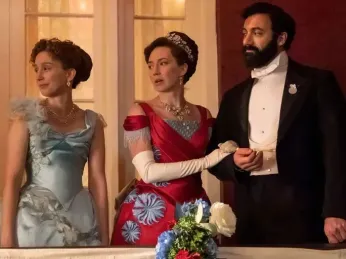
Aug 19
‘The Gilded Age’ – In the captivating third season, Fellowes serves upscale angst
Brian Bromberger READ TIME: 1 MIN.
Experts in the last two years have been saying the U.S with technological innovation (especially AI), wealth concentration among a growing class of mostly tech-related billionaires, along with economic inequality, might be entering a new Gilded Age.
The original one, the term coined by Mark Twain, ran from the 1870s till the early 20th century, featured rapid industrialization (especially railroads), technological innovations (electricity), and unprecedented wealth for robber barons (Rockefeller, Carnegie), while most of the working classes remained mired in poverty. Twain was satirizing the era’s materialism and corruption.
Variety reported that with Season 3 of Baron Julian Fellowes' “The Gilded Age,” just concluding last week, the show gained 30 percent more viewers than Season 2, with its highest audience for the final five weeks in a row.
Perhaps the reason more people are watching the series is that realizing with the nation now headed by a rapacious billionaire intent on favoring the rich and cutting aid to the poor, that we are indeed living in a new Gilded Age, so they might as well find out what the old Gilded Age was like.
Or perhaps the opulent sets and clothes (gloriously over the top ornate, reminiscent of “Dynasty” at its mid-1980s peak, complete with extravagant hats) appeals to our sensibilities, a campy soap opera where you can almost see the suds on your computer or cell phone screen.
But this season has been a watershed for the series, because it is much better than the previous two seasons. “The Gilded Age” is one of those rare series that improves with each season, rather than the usual creative ennui. The pace is much faster, advantageous here so you don’t notice how paper thin and clichéd the plots are.
The key turn was in the second season shift from the traditional old money Van Rhijn sisters to the rapacious nouveau-riche Russell couple, even though Agnes Van Rhijn (Christine Baranski) is still channeling the acerbic world-weary sarcasm of the Dowager Countess of Grantham (played by the late Maggie Smith) of “Downton Abbey” so she still gets to utter the series’ best lines (i.e. “Unhappy? What is this babble?”)

Ups and downers
In the first two seasons, there was the veneer of being socially conscious, so we had appearances by Clara Barton, with ‘journalist’ Peggy (Denee Benton) traveling down South to experience Jim Crow. Any pretense about wanting to promote social change has virtually vanished. Ada Forte (Cynthia Nixon) mourns the loss of her minister husband, who incidentally, came from a stinking rich family. After Agnes’ gay son Oscar (Blake Ritson) lost all her money in the 1880s version of a Ponzi scheme, leaving her penniless, last season, Ada saved the day with her unexpected windfall.
To deal with her grief, Ada takes up the temperance movement because she thinks it would have appealed to her late husband. She tries to summon temperance pledges from the staff and Agnes, almost all of whom ignore it. Temperance is played for laughs, even though it actually was an early eventually unsuccessful effort to deal with physical abuse of women, which skyrocketed when their husbands, brothers, or fathers got drunk. Her inconsolable mourning takes her to a fraudulent medium, played to comic genius by Andrea Martin.
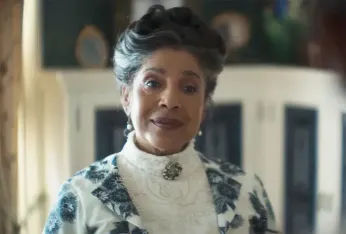
The biggest issue in the Van Rhijn household is who gets to sit at the head of the table (Agnes or Ada) and tell the staff what to do. Having shed any pretense about any concern for social issues or meatier substance, the closest we come to a public problem is when friend Aurora (Kelli O’Hara) has to deal with her husband’s leaving her for another woman. If she opts to divorce him, through no fault of her own, it will make her a social pariah, which in Fellowes’ world, is a fate worse than death. Tradition and stable values ultimately matter most with Ada observing, “Society’s changed Agnes. The trick is to accommodate the new without upsetting the boat.”
Peggy’s journalism career is now virtually ignored and the whole season focuses on her finally snaring a man. Nearly dying of pneumonia, she’s saved by a handsome Black doctor William Kirkland (Jordan Donica) with whom she slowly falls in love. His family is connected into the world of the Black American elite of Newport, Rhode Island.
Kirkland’s disapproving parents chiefly, playing against type as his hard-hearted priggish mother Elizabeth is the delicious Phylicia Rashad, who looks down on Peggy’s successful pharmacist father, because he was once a slave, revealing bigotry was not the sole province of white people alone. Rashad is the star of season 3, transforming snootiness and vicious innuendo into an art form.
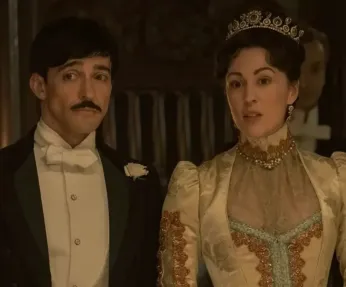
Love thwarted
Meanwhile, the dead-in-the-water romance between sweet but vacuous Larry Russell (Harry Richardson) and prim-to-a-fault van Rhijn niece Marian Cook (Louisa Jacobson) could unite the two dynasties. But the entire season revolves around the anger she has because he visited a whorehouse (but didn’t do anything), yet didn’t tell her. He then gets snitty that she doesn’t believe his alibi. While very attractive, they may be the most boring couple in all television, projecting zero chemistry between them.
The peak of the season for queer viewers is when Oscar’s male lover John Adams (Claybourne Elder) is killed. Being closeted, he can’t share his grief with anyone, though family and friends are picking up on his lingering sorrow. The show gives some insight into the cost of what it meant to be queer in an intolerant era.
Unfortunately, this downturn only lasts two episodes before the recovering Oscar is once again looking for a potential female suitor he can marry to provide a cover for his gay affairs, specifically the freshly widowed and wealthy Enid Winterton (Kelley Curran). Why is it that often the most unsavory characters in Fellowes’ series (remember the shady butler Thomas Barrow in “Downton Abbey”) are gay?
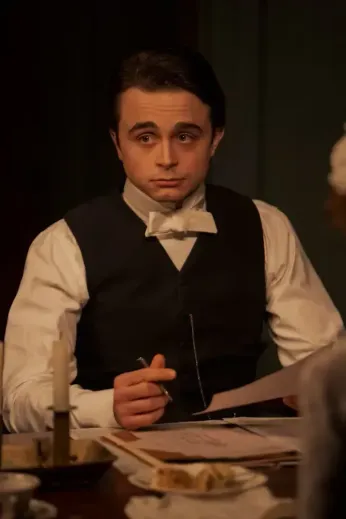
Beat the clock
The servants in this series remain its weakest link. One of the peaks of “Downton Abbey” were creating distinctive characters in the lower-class help. We really cared what happened to the warm-hearted housekeeper Mrs. Hughes and the blunt head cook Mrs. Patmore.
In the “Gilded Age,” Fellowes has failed to depict the underclass with any intriguing characters. The entire season concerns Van Rhijn footman Jack Trotter (Ben Ahlers) becoming rich after having sold his invention, an alarm clock. He wants to remain a footman by keeping his newfound wealth a secret because his coworkers are his surrogate family. It’s ludicrous beyond belief and viewers will not give care about any of them.
Fittingly, the main focus of season 3 is the relationship between the Machiavellian Bertha Russell (the sublime Carrie Coons), who cares only about her social position, and her amoral robber baron husband George (the magnificent Morgan Spector), who is obsessed with building the first intercontinental railroad by any means possible. In fact, it was their mutual ruthlessness that became the aphrodisiac of the relationship.
But there’s trouble in paradise, because Bertha is intent on pimping her daughter Gladys (the miscast Taissa Farmiga, stiff as a board) to marry the English Hector, Duke of Buckingham, so she will have the highest social position to influence worldly affairs.
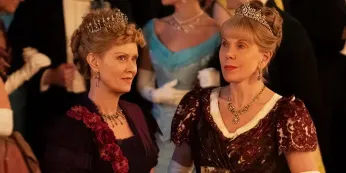
Dollar princess
Gladys initially rebels, aided by her father, but eventually surrenders to the inevitable, in a Downton Abbey retread of the rich American heiress (ala Cora Grantham) marrying British nobility with her, the ‘dollar princess,’ gaining an aristocratic title, prestige, and societal ammunition, while he gets the money.
This drives a wedge between the Russells with George screaming at Bertha, “I’m ruthless in business, not with the people I love, like you.” Will they be able to iron out their differences in pitiless ambition?
The closest the series comes to an overarching theme (besides the paramount importance of money in one’s life) is how women wield influence in a world run by men and how their fates are dictated by the males in their lives, epitomized by Bertha’s remark to her husband, “Men are forgiven for their indiscretions and women are punished. It’s not fair.”
And yet there’s an addictive quality which draws you in, despite your head saying, why are you ogling this classy melodramatic, though well-produced, drivel? It might be due, with a few exceptions, to the superb casting, mainly of veteran Broadway stage actors, who make the most of brief flimsy scenes.
It’s actually a creative feat that we give a damn about the antihero Russells, both of whom are despicable. Of course, deep down we want these wealthy characters to be miserable, believing that fabulous riches don’t protect you from the vicissitudes of life (or attempted murder). It’s all hilarious fluff with delicious eye candy, trivial historical pomposity masquerading as prestige television, though this series will never be the cultural touchstone “Downton Abbey” briefly became.
Still, it’s an entertaining, pleasant diversion that doesn’t deserve to be this enjoyable and yet it is, so we will eagerly be watching next year, now that the series has been renewed for a fourth season.
https://www.hbomax.com/shows/gilded-age/
